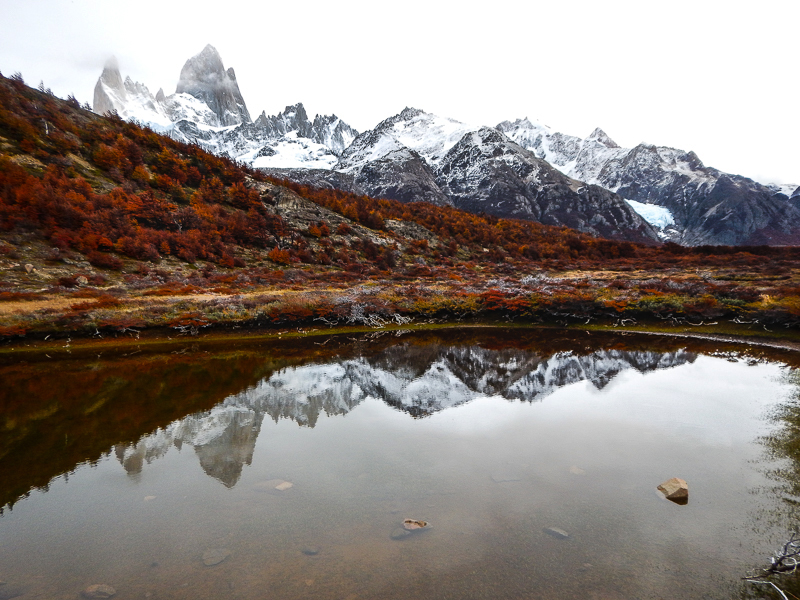CHACABUCO VALLEY, CHILE — I remember my first glimpse of Patagonia. My parents had given me a calendar of mountain images one Christmas and the photo for November — Patagonia — was so alarmingly beautiful, I thought it was fake.
After the calendar year passed, I carefully tore that picture out and pasted it inside the canopy of my truck before a climbing road trip. I would lay on top of my sleeping bag staring at the photo’s charcoal walls of perfect, unscarred rock that stood like a fortress above a precious lake coloured like the waters of the Caribbean. Lining its shores and stretching out to cover the vast landscape was a carpet of short, sturdy brush with purple flowers. The contrast of the stark rock walls and the delicate purple petals made my heart melt.
Being a 20-something avid hiker and rock climber at the time, I wanted to go there to see for myself if this “picture” perfect place at the end of the Earth truly exists.
Twenty years later, that picture comes alive when my boyfriend and I reach Patagonia on our whirlwind round the world trip. Tears roll down my cheeks when the three granite towers of Torres del Paine come into view.

Above: Patagonia stretches between Chile and Argentina and is a breathtaking sight.
Later, while on a day hike, I’m literally left breathless when I see Fitz Roy and Cerro Torre, whose jagged peaks rise like fingers into a low-hanging sky.
During our travels, Dave and I visited many world-famous places that had captured our hearts through photos. While most were truly impressive to see in person, some were sadly disappointing. The crowds of tourists would take away from the experience, or, worse, we would find these sacred places littered with garbage or otherwise unkempt.
Patagonia was the exception.
A photograph, no matter how beautiful, just does not do this special place justice. The adjective has not yet been written that can best describe Patagonia’s beauty.
We arrived in April, which is autumn in the southern-hemisphere. Unquestionably this is the best time of year to be in Patagonia. From June to August, many amenities are closed and from December to March, peak rates apply. During the fall, though, Patagonia sees far less travellers, reservations are seldom needed and tourist services are often discounted.
As I read more about this region that covers 258,000 acres and is shared by Chile and Argentina, I learned all about its sometimes gruelling and inhospitable climate.
The reason the monolithic peaks looked so smooth and unblemished during the summer was because of winds travelling upwards of 120 km/h blast across their faces, creating a power-washing type of exfoliation.

Above: Fitz Roy, in the distance, and Cerro Torre are Patagonia's two most famous monoliths.
In winter, these same peaks wear a prickly coat of impenetrable hoar frost while their tops are covered in thick clouds stretched like snagged cotton balls on their spiky points. Each year, climbers attempt to summit Patagonia’s famous monoliths, like Fitz Roy and Cerro Torre, and are beaten into submission from storms that frequently blow in with little warning.
Exploring during the months of March to May means the winds are far less intense, storms have settled down and colour is at its best for photography.
While hiking along a colourful 20-km loop that started in the sweet little Argentinean town of El Chaltén, the scenery looked like an artist had taken red, yellow and orange paints and created the jaw dropping scene.
Even when it wasn’t sunny, the colours seemed to stand out more. For example, a certain shade of turquoise is much more prevalent when it’s cloudy in the depth of the glaciers, which during the past several years are actually advancing in some areas of Patagonia.
We were hoping to arrive early enough in the fall to taste the calafate berries, an indigenous blueberry look-alike that flourishes under trees and shrubs in the lower hills. Local folklore suggests, “anyone who eats a calafate berry will return to Patagonia’s captivating landscape.”

Above: Patagonia is the perfect retreat for migrating rare birds.
While Dave and I didn’t get to taste the berries, there remains a deep urge to return regardless.
Patagonia remains a place highly protected by activists and visitors to the region. A new national park is underway in Chile’s Chacabuco Valley, encircling 650,000 acres for public access. Torres Del Paine is already a National Park of 448,283 acres, which was first established in1959 and designated a World Biosphere Reserve by UNESCO in 1978.
In Patagonia, you’ll find everything from grasslands, pampas and even deserts to beaches, lakes and forests. It’s not just a place for hardcore mountaineers or hard-brained geologists. Day hikes and multi-day treks are among the more popular activities, but many people come for fly fishing, horseback riding and photography tours as well.
It is a highly rewarding place that requires some effort to get to, but you’ll never regret going and Patagonia will become a picture in your mind. •
About the Author
Heather Lea has had over two decades of freelance writing experience with over 60 published articles and stories in various travel and outdoor publications. From 2005 to 2015, she founded and operated an arts and culture magazine in Revelstoke, B.C. before selling her business to help fund her trip around the world. More stories of Heather's adventures can be found at http://www.ridingfullcircle.com